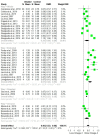Oilseed Supplementation Improves Milk Composition and Fatty Acid Profile of Cow Milk: A Meta-Analysis and Meta-Regression
- PMID: 35804541
- PMCID: PMC9265076
- DOI: 10.3390/ani12131642
Oilseed Supplementation Improves Milk Composition and Fatty Acid Profile of Cow Milk: A Meta-Analysis and Meta-Regression
Abstract
Oilseed supplementation is a strategy to improve milk production and milk composition in dairy cows; however, the response to this approach is inconsistent. Thus, the aim of this study was to evaluate the effect of oilseed supplementation on milk production and milk composition in dairy cows via a meta-analysis and meta-regression. A comprehensive and structured search was performed using the following electronic databases: Google Scholar, Primo-UAEH and PubMed. The response variables were: milk yield (MY), atherogenic index (AI), Σ omega-3 PUFA, Σ omega-6 PUFA, fat, protein, lactose, linoleic acid (LA), linolenic acid (LNA), oleic acid (OA), vaccenic acid (VA), conjugated linoleic acid (CLA), unsaturated fatty acid (UFA) and saturated fatty acid (SFA) contents. The explanatory variables were breed, lactation stage (first, second, and third), oilseed type (linseed, soybean, rapeseed, cottonseed, and sunflower), way (whole, extruded, ground, and roasted), dietary inclusion level, difference of the LA, LNA, OA, forage and NDF of supplemented and control rations, washout period and experimental design. A meta-analysis was performed with the “meta” package of the statistical program R. A meta-regression analysis was applied to explore the sources of heretogeneity. The inclusion of oilseeds in dairy cow rations had a positive effect on CLA (+0.27 g 100 g−1 fatty acids (FA); p < 0.0001), VA (+1.03 g 100 g−1 FA; p < 0.0001), OA (+3.44 g 100 g−1 FA; p < 0.0001), LNA (+0.28 g 100 g−1 FA; p < 0.0001) and UFA (+8.32 g 100 g−1 FA; p < 0.0001), and negative effects on AI (−1.01; p < 0.0001), SFA (−6.51; p < 0.0001), fat milk (−0.11%; p < 0.001) and protein milk (−0.04%; p < 0.007). Fat content was affected by animal breed, lactation stage, type and processing of oilseed and dietary NDF and LA contents. CLA, LA, OA and UFA, desirable FA milk components, were affected by type, processing, and the intake of oilseed; additionally, the concentrations of CLA and VA are affected by washout and design. Oilseed supplementation in dairy cow rations has a positive effect on desirable milk components for human consumption. However, animal response to oilseed supplementation depends on explanatory variables related to experimental design, animal characteristics and the type of oilseed.
Keywords: CLA; atherogenic index; experimental design; milk fatty acid; roasted; washout.
Conflict of interest statement
The authors declare no conflict of interest.
Figures







Similar articles
-
Effect of monensin and vitamin E on milk production and composition of lactating dairy cows.J Anim Physiol Anim Nutr (Berl). 2013 Aug;97(4):666-74. doi: 10.1111/j.1439-0396.2012.01307.x. Epub 2012 Apr 26. J Anim Physiol Anim Nutr (Berl). 2013. PMID: 22533457 Clinical Trial.
-
Grape seed and linseed, alone and in combination, enhance unsaturated fatty acids in the milk of Sarda dairy sheep.J Dairy Sci. 2016 Mar;99(3):1725-1735. doi: 10.3168/jds.2015-10108. Epub 2016 Jan 13. J Dairy Sci. 2016. PMID: 26774716
-
Effects of feeding extruded linseed on production performance and milk fatty acid profile in dairy cows: A meta-analysis.J Dairy Sci. 2017 Jun;100(6):4394-4408. doi: 10.3168/jds.2016-11850. Epub 2017 Apr 5. J Dairy Sci. 2017. PMID: 28390715
-
Differential effects of oilseed supplements on methane production and milk fatty acid concentrations in dairy cows.Animal. 2019 Feb;13(2):309-317. doi: 10.1017/S1751731118001398. Epub 2018 Jun 19. Animal. 2019. PMID: 29914588
-
Impact of Using Oilseed Industry Byproducts Rich in Linoleic and Alpha-Linolenic Acid in Ruminant Nutrition on Milk Production and Milk Fatty Acid Profile.Animals (Basel). 2024 Feb 6;14(4):539. doi: 10.3390/ani14040539. Animals (Basel). 2024. PMID: 38396507 Free PMC article. Review.
Cited by
-
The Effects of Feeding Milled Rapeseed Seeds with Different Forage:Concentrate Ratios in Jersey Dairy Cows on Milk Production, Milk Fatty Acid Composition, and Milk Antioxidant Capacity.Life (Basel). 2022 Dec 23;13(1):46. doi: 10.3390/life13010046. Life (Basel). 2022. PMID: 36675995 Free PMC article.
-
Capsaicin as a Dietary Additive for Dairy Cows: A Meta-Analysis on Performance, Milk Composition, Digestibility, Rumen Fermentation, and Serum Metabolites.Animals (Basel). 2024 Apr 2;14(7):1075. doi: 10.3390/ani14071075. Animals (Basel). 2024. PMID: 38612314 Free PMC article.
-
Toward assessing the role of dietary fatty acids in lamb's neurological and cognitive development.Front Vet Sci. 2023 Feb 14;10:1081141. doi: 10.3389/fvets.2023.1081141. eCollection 2023. Front Vet Sci. 2023. PMID: 36865439 Free PMC article.
-
Effects of PUFA-Rich Dietary Strategies on Ruminants' Mammary Gland Gene Network: A Nutrigenomics Review.Metabolites. 2022 Dec 27;13(1):44. doi: 10.3390/metabo13010044. Metabolites. 2022. PMID: 36676968 Free PMC article. Review.
-
Influence of dietary oils rich in omega-6 or omega-3 fatty acids on rumen microbiome of dairy cows.Transl Anim Sci. 2023 Jul 1;7(1):txad074. doi: 10.1093/tas/txad074. eCollection 2023 Jan. Transl Anim Sci. 2023. PMID: 37483683 Free PMC article.
References
-
- Steijns J.M. Milk ingredients as nutraceuticals. Int. J. Dairy Technol. 2001;54:81–88. doi: 10.1046/j.1364-727x.2001.00019.x. - DOI
-
- O’Mahony J.A., Fox P.F. Milk: An overview. Milk Proteins. 2014:19–73. doi: 10.1016/B978-0-12-405171-3.00002-7. - DOI
-
- Collomb M., Schmid A., Sieber R., Wechsler D., Ryhänen E.L. Conjugated linoleic acids in milk fat: Variation and physiological effects. Int. Dairy J. 2006;16:1347–1361. doi: 10.1016/j.idairyj.2006.06.021. - DOI
-
- Vargas-Bello-Pérez E., Garnsworthy P.C. Trans fatty acids and their role in the milk of dairy cows. Int. J. Agric. Nat. Res. 2013;40:449–473. doi: 10.4067/S0718-16202013000300001. - DOI
Publication types
LinkOut - more resources
Full Text Sources

